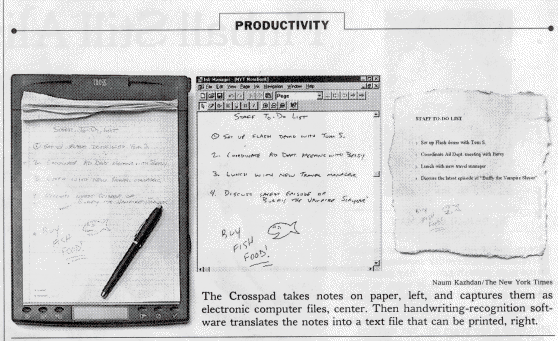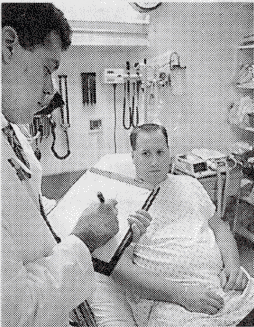


When Dr. Oreste Bruni rushes around the emergency room at eh massapequa General Hospital in Seaford, N.Y., hand-on medicine is not his only occupation. Like all doctors in that fast-paced world, he's busy taking notes - notes to guide later treatment and help insure payment for both him and the hospital. Such notes can even become vital evidence if a malpractice suit is filed.
In the early 90's Dr. Bruni tried to move into the electronic age by taking notes on laptop computers that used special screens and pens rather than keys for entering text and commands. He bought and tried four different models, but their awkward weight, size and shape ultimately forced him to abandon them all.
Dr. Bruni has returned to taking notes with a ballpoint pen and a standard yellow notepad, 8 1/2 by 11 inches, but there is a difference. Since last spring, he has been slipping those pads onto a clipboard that silently creates an electronic version of his medical charts as the writes with ink on paper. Then, if Dr. Bruni chooses, handwriting-recognition software takes those electronic records and translates them - more or less - into text that can be handled by a word-processing program.
He has switched to one of the devices that is making people take a new look at word-recognition software: the crosspad, developed by International Business Machines and the pen maker A. T. Cross.
Handwriting-recognition software has generally been tailored for either large-or small-scale use. Huge systems are used by large corporations and agencies like the United States Postal Service. At the other end, personal digital assistants like 3Com's Palm Pilot offer limited recognition ability. The Crosspad's Ink Manager software and Smartwriter by Advanced Recognition Technologies are trying to bring some of the more advanced features of larger systems to consumers.
The Crosspad, the latest attempt to link handwriting and computers, uses a pen with a miniature radio transmitter. While the user writes in ink, the pen beams its movements to a computer in the clipboard, which assembles the data into a digital image of the scribblings. The Crosspad has enough memory to hold an electronic record of more than 50 written pages. The computer files can be uploaded onto any computer that has Pentium processor and runs Windows 95 or 98 or NT.
I.B.M. and Cross hope that the Crosspad, which came on the market in the spring, will join P.D.A.'s like the Palm Pilot as a handwriting-recognition gadget of choice for well-heeled executives and professionals.
On Monday, Cross introduced a smaller, lighter model that uses steno-size notebooks. I.B.M. and Cross officials say they expect other companies to have Crosspad copycats available by spring.
The pages captured by a Crosspad are like fax images in a computer - they are graphical depictions of text and drawings, not text that can b manipulated by a word-processing program. The Crosspad includes handwriting-recognition software to convert such notes into text, but such software tends to make a lot of errors, depending on the handwriting. One early handwriting-recognition product, the Newton from Apple, became widely known after it was parodied in the Doonesbury comic strip because of the comical errors its software sometimes produced. Palm Pilots and similar P.D.A.'s also offer handwriting recognition, but users must write in special script with a stylus on small liquid-crystal-display screens.
James Landay, a professor specializing in user-interface research at the University of California at Berkeley, said that with P.D.A.'s "the screen resolution is pretty poor and you're writing on something smaller than a Post-It note.". He is now trying a Crosspad.
Pen-based laptops have evolved as heavy-duty tools for professionals in the field. They tend to have a short battery life and slippery writing surfaces. One pen-based Thinkpad that I.B.M. marketed in hospitals weighed nearly seven pounds.
"Nurses weren't going to carry it around all day unless they were ex-East German swimmers," recalled Krishna Nathan, who studies hand-writing recognition at I.B.M.'s Thomas J. Watson Research Center, where he is the laboratory's senior manager for consumer devices.
I.B.M. changed its thinking with the Crosspad. "We were focusing on trying to solve the problem of the pen and forgot about everything that paper's really good at," Mr. Nathan said. "After all, paper offers the ultimate in portability."
The Crosspad's main advantage over paper alone is the ability to search for bits of information in notes and retrieve them. Crosspad users can circle words to make them keywords that can be searched for later..
The ultimate prize, of course, with products like the Crosspad is the ability to translate notes into standard computer text. The Crosspad comes with I.B.M. Ink Manager software to do that.
One person who uses the handwriting-recognition software to convert his Crosspad notes into text is Marc Demarest, chief executive of DP Applications, a software developer in Portland, Ore. He immediately converts all his notes into text and stores them in programs like Microsoft Word, he said, never saving the graphic images of his writing.
But neither I.B.M. nor Cross seems willing to trumpet the ability to transform notes into computer text. Officials in both companies vividly remember the mockery directed at other ambitious handwriting-recognition claims and are cautious about claiming too much.
"I would describe Crosspad first and foremost as a note-capture and note-management device," said Brian Mullins, director of marketing for the Cross Pen Computer Group. "The level of satisfaction with our product for handwriting recognition is all over the board." Despite the disclaimers, the Crosspad is clearly, along with P.D.A.'s, the latest in a series of steps to restore respectability to handwriting recognition.
Mr. Nathan says sorting out pen scratches is a more difficult problem than its sibling software challenge, voice recognition. "Speech has evolved as a means of communication," he said. "There's no point in me making sounds if you can't understand them. But when we come to writing, we do not tend to write for others, we tend to write for ourselves." An unscientific survey of 400 executives by Cross found that 49 percent of them had trouble reading their own handwriting.

As people use computers more, the handwriting problem becomes more difficult. In two decades of grappling with the problem, Prof. Sargur Srihari, director of the Center of excellence for Document Analysis and Recognition at the State University of New York at Buffalo, has noticed a steady decline in the quality of handwriting, at least in affluent nations.
"It seems there is less of an emphasis on it because of computers," Professor Srihari said. "There is a sense that classroom time that was once devoted to penmanship is now devoted to keyboarding."
But handwriting remains overwhelmingly the favored method for taking notes at business meetings, in schools and for many job activities. The Cross survey found that 72 percent of its respondents still took handwritten notes on paper. "In my world, there is nothing more annoying than someone in a meeting banging away on a laptop keyboard - rat-a-tat-tatting on the damned thing." Mr. Demarest wrote in an E-mail message. "It's intrusive, ostentatious and ultimately stifles the free flow of conversation."
Software for handwriting recognition uses vast digital libraries of writing samples. Complex pattern recognition algorithms - mathematical approaches to the problem - sort through the samples and develop statistics on the most likely forms letters and numbers take. Handwriting recognition works reasonable well if users print carefully in capital letters (called discrete handwriting) and limit the amount of text. The Palm Pilot solves the problem by having people learn to write in a special manuscript-type script it calls Graffiti.
Casio's Cassiopeia E-10, which uses Microsoft's Windows CE operating system, has a slightly more sophisticated hand writing-recognition program know as Jot, from the Communication Intelligence Corporation. It recognizes characters that more closely resemble standard printing and allows users to make notes anywhere on the screen.
Recognizing individual letters and numbers is the easy part. "Computers are pretty good today at individual recognition of shapes in isolation," Professor Srihari said. "Recognizing words is where they fail."
Handwriting-recognition programs that are more ambitious than those found in most P.D.A.'s use two techniques simultaneously to translate scribbles into words and sentences. The holistic approach tries to pluck out entire words that match dictionary entries. Analytical algorithms break down pen strokes into fine divisions to discover, using probability, individual letters that can then be assembled into words.
Handwriting-recognition programs must be trained to read a specific user's writing style. The Crosspad's Ink Manager software requires a tedious teaching process. The user copies such phrases as, "Do you know why America presently accounts for about 50% of world tuna consumption?" I.B.M. says Ink Manager can fully trained in about a half hour. Mr. Demarest said he had toiled with it for about 10 hours and wound up with and astounding accuracy ret of 95 percent.
Even Mr. Mullins, the person at Cross responsible for selling the Crosspad, says the recognition software often fails him. "I have terrible handwriting," he said.
After training the Crosspad software for a half-hour, I entered some of the interview notes for this article but had little success. "They are very heavy" was rendered by Ink Manager as "REX we in lady." Large sections of notes looked as if they had been written in a long-forgotten language with a few contemporary English words.
Crosspad is not the only product Cross offers with handwriting recognition. The iPen Pro, a digital writing tablet that connects to Windows- based PC's, is supplied with Smart-writer requires training, although the company, perhaps optimistically, says the process can be completed within five minutes. Unlike the I.B.M. software, Smartwriter converts each word into text as it is written.
The Super Bowl for handwriting recognition might well be the next United States Census, in 2000. The Census Bureau plans to process all 1.4 billion personal and business forms electronically. Using a handwriting-recognition system developed by Associated Solutions of Dallas, the bureau is hoping for 98 percent accuracy. If the software can do that , the census may finally eliminate the sour taste Apple's Newtown brought to handwriting recognition.